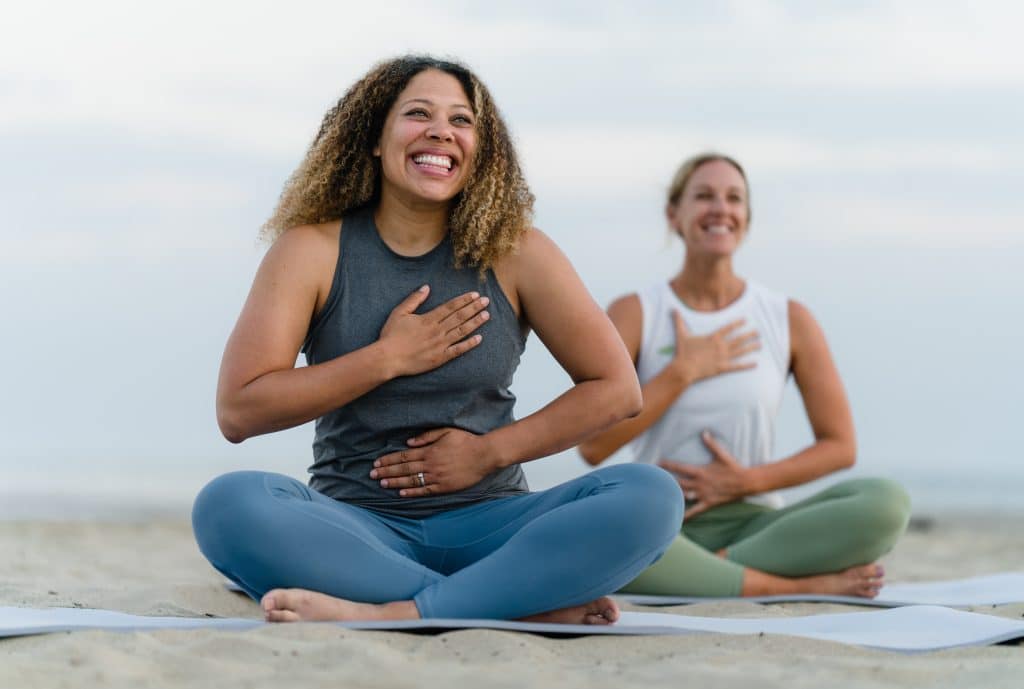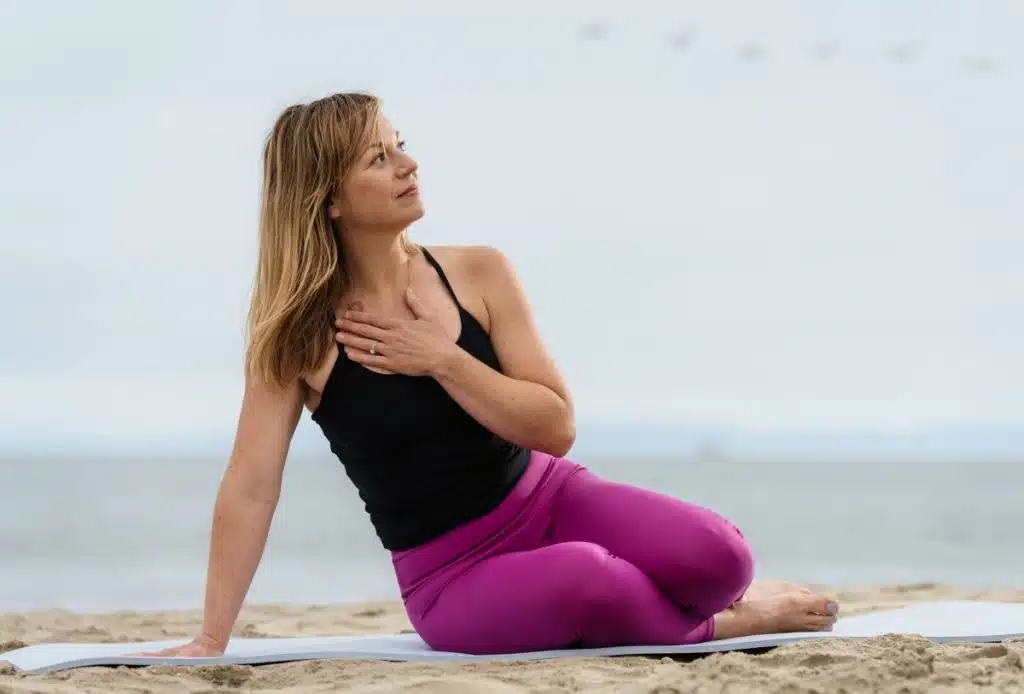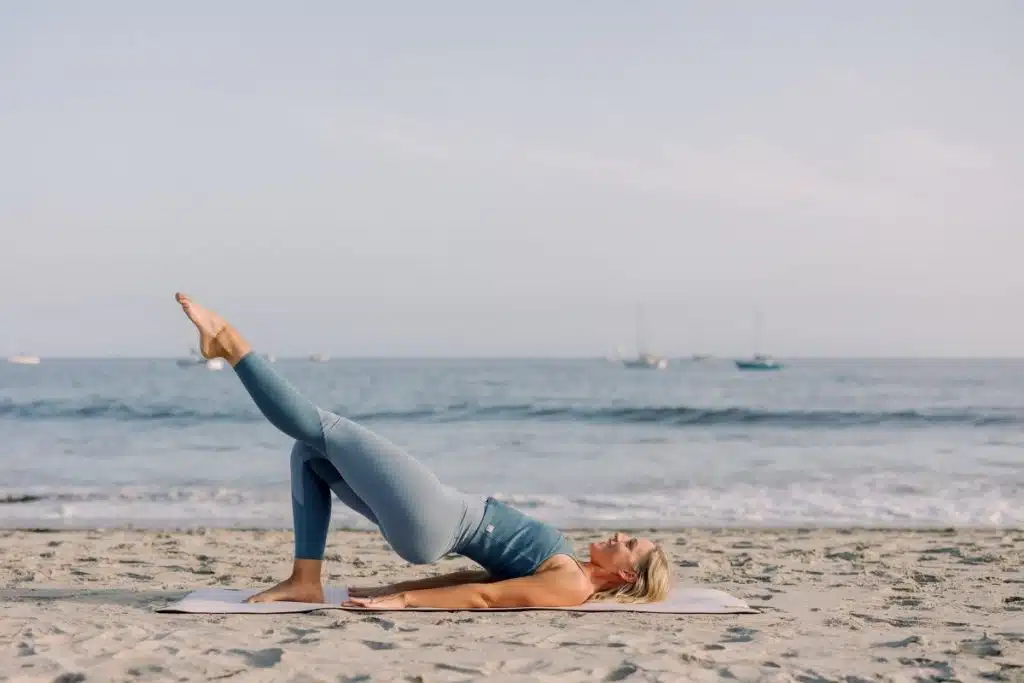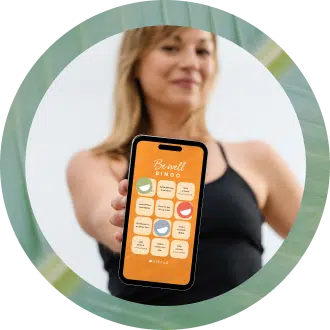
Hi Lindywell community! Kiesha here. I’m so excited to be joining the team as the Head of Breathwork and Somatic Programs.
In addition to providing you high quality, effective and efficient Pilates workouts you can do from home (or on the road), Lindywell is now also a place where you can find guided breathwork sessions and intentional breathing exercises to help you reduce stress, clear your mind, increase your energy and improve your mental health.
You may already be a dedicated breathwork fan, or you may be curious what breathwork even is.
The definition of breathwork is quite simple: It is a conscious practice of using your breath to help shift your emotions and create the desired outcome.
While breathwork is trending right now (and for good reasons!), it’s an ancient practice with roots in southeast Asia that has been utilized for years – in many different ways.
As a trauma-informed breathwork facilitator and a somatic life coach, I’m passionate about helping equip people with somatic tools to address trauma in the body. Healing isn’t a linear process, but it’s possible, and I’m proud of that.
Understandably, there are some questions about breathwork and we’ve listened to you, our community, to answer your questions. Here are a few answers to the most frequently asked questions.

1. What are the benefits of breathwork?
80% of us have some level of breathing dysfunction, from shallow upper neck and chest breathing, mouth breathing, or altered breathing rhythms, that keep us in stress states. We need to be talking about this and in order to be well, we need to consider how we breathe.
Babies and cats embody breath the best. Think of your cat or a baby. How do they breathe? When they are resting, you see their bellies rise and fall. Just picture the sweetness of the rhythms of their breath. #Goals, right?
This is how we were born to breathe. Incredibly, we regulate ourselves even from the youngest age. Over time we form bad habits based on stress and life factors, and this is where breathwork comes in.
The benefits of breathwork are many. It can help to:
- Decrease stress
- Improve sleep quality
- Increase mindfulness
- Reduce high blood pressure
- Improve lung function (can help those with asthma, bronchitis, and pneumonia)
- Enhance cognitive performance
- Reduce cigarette cravings
2. How does breathwork help calm my mind and address stress responses like “fight or flight”?
When we mindfully breathe, we slow our heart rate down, thus signaling to our
brains that we are not in a state that requires hypervigilance.
What type of breathing comes to mind when you think of “fight or flight”?
- Shallow?
- Rapid?
- Are there any racing thoughts?
In order to increase oxygen, our lungs must work harder when we are in this state.
When we slow our breathing, we signal to our brains that we are okay, and our parasympathetic cues the nervous system to calm us down.
Long, deep breaths can also manage our stress responses to help decrease anxiety, fear, racing thoughts, a rapid heartbeat, and shallow chest breathing.
These responses can impact our physical, mental, and emotional health and longevity. Toxic stress negatively impacts our overall wellness and longevity, but breathwork is one somatic (body-based) tool that can create a sense of calm and well-being.
3. Why do we always breathe in through the nose and out through the mouth versus in and out through the nose? Is there something specific that it does for the body?
I’ll answer this in two parts.
First, at Lindywell, we do a variety of techniques. There are so many different breathing exercises. Sometimes they specifically call for nostril or mouth breathing for a reason, and sometimes, it doesn’t matter.
When I instruct, I’m giving you suggestions because everyone is at a different place and may or may not be able to access certain movements that day.
In breathwork, mouth breathing is cooling and helps us shift states when we do the 3 part open mouth breath (a style used during longer breathwork sessions known as a conscious connected circular breathwork pattern).
The elementary teacher in me relates this to teaching young children how to spell. Spelling the word apple correctly doesn’t matter at the beginning. It may matter later, but I always asked my students, “What do you hear? I would ask, “Can you stretch out the sounds?” I want them to let go of perfection, get curious, enjoy the process, and trust their minds as young writers. While they may look different, Apl and Apple mean the same thing.
Similarly, with breathwork, one way may be how it’s technically done, but how you show up today is valid and valuable. This is similar to Robin’s approach to breathing in Pilates as well!
Like my former students, I want you to let go of perfection or the need to be a purist, get curious and be playful about your body and breath, and trust your mind. I will let you know if a strategy requires nasal or mouth breathing.
Secondly, as a general rule, we should breathe through our noses in our daily lives. This is for optimal health (mouth breathing comes with many issues affecting our sleep, teeth, weight, and mental health).
Mouth breathing bypasses the functions of the nose, which include warming, humidifying, and filtering the air we breathe.
Nostril breathing allows your lungs to be more efficient in oxygen absorption. It also activates the lower part of the lungs when doing breathwork, thus taking in more oxygen.
However, in breathwork, when we are doing targeted exercise for a short time to achieve a desired result, short durations of mouth breathing aren’t a problem.
Some exercises call for either nose or mouth breathing for a specific reason, but it doesn’t matter unless specified. If you have a stuffy nose and all you can do is breathe through your mouth, it would be better to do that than the way I may instruct (or suggest) because the benefits of breathwork are worth it.
4. How to change your mindset of “this won’t work for me”?
The mind-body connection is real and is one of the best ways to take charge of your health. So much of life is not in your control, but knowing that your thoughts are connected to emotions and that those emotions reside in the body is powerful. Knowing that this connection impacts your overall wellness gives you great motivation to do something about it.
Research supports the role of the mind-body connection in healing and recovery.
“Over the past 30 years, neurobiological research has shown that the placebo effect, which stems in part from an individual’s mindset or expectation to heal, triggers distinct brain areas associated with anxiety and pain that activate physiological effects that lead to healing outcomes”.Stanford University
Healing and recovery are more than acts that require medical attention and support; you are a part of the equation. Our thoughts affect our ability to recover.
“Many scientists believe there is a strong mind-body connection that can affect healing. Sometimes the trauma to the body and negative thoughts can lead to stress, depression, and anxiety. Occasionally, the injury leads to fear about getting injured again. These negative thoughts and emotions can affect recovery.” Bone-Joint
“Your body responds to the way you think, feel, and act. This is one type of “mind/body connection.” When you are stressed, anxious, or upset, your body reacts physically. For example, you might develop high blood pressure or a stomach ulcer after a particularly stressful event, such as the death of a loved one. Family Doctor
Try reframing your thoughts and get curious by instead asking yourself “Could this work for me?” and be open to exploring the ways your mindset can impact your experience.
5. How to get started with breathwork?
Join Lindywell! Try different techniques and don’t give up. Like everything else in life, it takes practice. I’d love for you to join me and an amazing group of instructors!
After downloading our app, here are some steps for beginners and experts alike:
1. Start paying attention to your breath more often throughout the day. Right now, at a stoplight, upon rising, during Pilates, before sleep. Make it a habit to be a student of the way you breathe.
2. Get curious. Can I breathe more deeply, more slowly, and bring my mind back to how I breathe throughout the day?
3. Play! We encourage you to try different sessions in the Lindywell app. There are short guided sessions and longer, deeper sessions – something to suit your mood each day. Each style and experience is different, so be open to trying sessions more than once.
4. Subscribe and follow Lindywell: We want breathwork and Pilates to be as accessible as possible. Subscribe to our newsletter for free tips and tools. Follow us on Instagram @wearelindywell for daily breathwork inspo and IG Live tutorials. Join one of our free challenges that let you experience that power of grace over guilt pilates, breathwork, and nourishment.
5. Breathwork feels intimidating to me; can you explain why it might feel scary to try?
Oh, friend, this is so real; I feel this in my soul.
Meditation, breathwork, and basically anything that slows us down and gets us into our bodies can be scary. Hear me clearly:
You are not alone.
That is why you need someone who is trauma-informed as a guide. You need someone to hold space for you, and don’t take for granted that something as simple as breathing can be terrifying based on what you have been through and what is happening in your body.
This is a common experience, and in my teaching, whether live, online, or in-app, I teach from a place of grace and gentleness.
6. Can breathwork reduce anxiety?
Yes! Deep breathing slows your heart rate and signals your body to calm down.
As someone with a lot of anxiety experience, I know how important this is.
Learning about my nervous system and how to nourish it has given me power and agency in my body. That, in and of itself, has reduced my anxiety.
Controlled breathing leads to physiological changes in the body. Think about when a child is upset and someone they love holds them and takes deep breaths with them. What happens? It regulates their breathing and shifts their state. You can do this same thing for yourself with controlled breathing. The benefits only increase when practiced regularly.
Deep breathing signals the body to slow your heart rate and lower blood pressure, which reduces cortisol levels (the stress hormone). See the list of benefits in question 1.
I can’t wait to get to know all of you in the Lindywell community better – and can’t wait to see you in the app for your next breathwork session!
Until then…remember to breathe.
Kiesha










4 thoughts on “Your Breathwork Questions Answered!”
Thank you for this session. It was amazing. Similar yet different from yoga breathing. I love your technique!
Cheryl
You are so welcome, Cheryl! We are so glad that you enjoyed it! 🙂
Hi, I don’t know how to message Kiesha one on one, not any good with technology. But I’ve returned from Mayo in Phoenix and did get answers to my problems related to breathing.
She can e-mail me and I can give her a reply if she wants a follow up.
Thank you, Dan
Hi Daniel! We are so happy to hear that you’ve received some answers and hope that you are receiving all of the medical care and treatment that you might need. You are always welcome to reach out to the team at [email protected]. We are here for you and always happy to help!